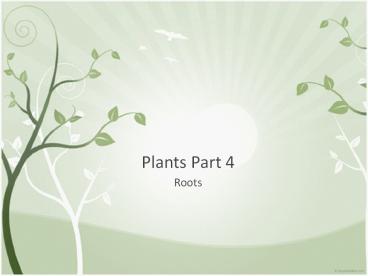Plants Part 4 - PowerPoint PPT Presentation
1 / 6
Title:
Plants Part 4
Description:
Plants Part 4 Roots Roots Serve 3 important functions: anchors, absorb minerals and water, and they transport those minerals and water Two main types of roots ... – PowerPoint PPT presentation
Number of Views:147
Avg rating:3.0/5.0
Title: Plants Part 4
1
Plants Part 4
- Roots
2
Roots
- Serve 3 important functions anchors, absorb
minerals and water, and they transport those
minerals and water - Two main types of roots
- Taproots are long and thick and have secondary
roots emerging from that root. Dicots have
taproots. - Fibrous roots are many roots of about the same
size, each with secondary roots. Monocots have
fibrous roots.
3
- Another type of root called the adventitious
roots are when the roots emerge from other
tissues like the stem and leaves, and prop up the
plant in support. - Tuberous roots are a lateral root that is
specialized to store carbohydrates. Example
yams, cassava
4
Types of Tissues in Roots
- Epidermis is one cell layer thick and is the
outermost layer of the root. It protects and
absorbs water and mineral from the soil. Has
specialized cells that form root hairs that
increase surface area. - The cortex is a layer of cells found just below
the epidermis and has some cells that store
molecules like starch, transport water and
minerals from the epidermal cells to the centre
of the root by osmosis. - Cortex has a wax coating on the inner layer
called the endodermis.
5
- The Casparian strip surrounds the endodermal
cells, prevents water from entering back into the
cortex. Minerals must be pumped by active
transport into the vascular cylinder. This layer
controls the movement of water and minerals.
6
- The vascular cylinder contains the plants
conducting tissues the xylem and the phloem. - The xylem conducts water and minerals to the
leaves - The phloem conducts the sugars from the leaves to
other parts of the plant. - Monocot root vs dicot root































